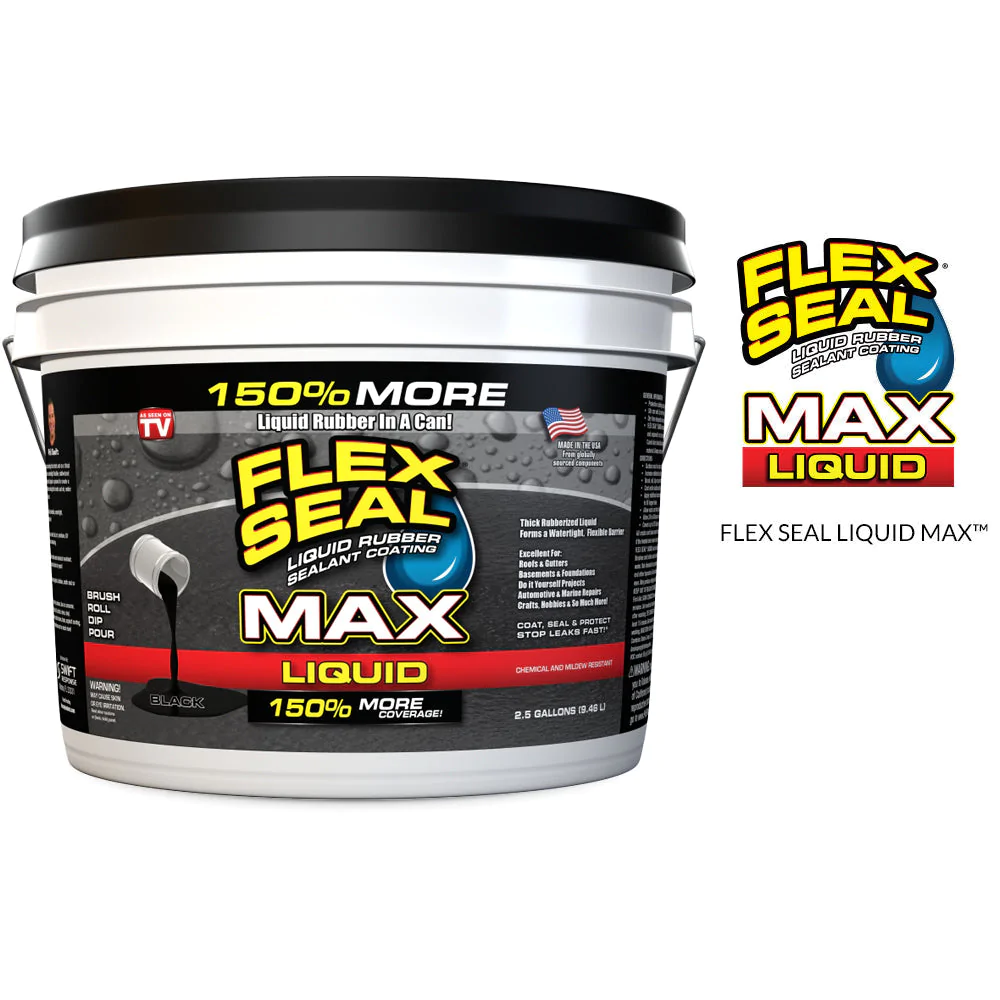The best Flex seal product for sealing cracks in your concrete surfaces such as the driveway or the basement is the Flex Seal Liquid. Flex Seal Liquid seals out air, water, and moisture, it’s also mildew, chemical and UV-resistant. You can apply Flex Seal directly onto concrete surfaces by brushing, rolling, dipping or pouring it on.

Flex Seal Liquid is an extremely thick rubber coating that can be applied with a brush, roller, or pour. Make sure to read the directions before beginning in order to use Flex SealLiquid correctly and safely. The video below provides more tips on how to use this product effectively.
Does Flex seal adhere to concrete?
Yes, flex seal adheres to several surfaces such as wood, metal, tile, concrete, masonry, fabric, glass, plastic, aluminum, porcelain, drywall, rubber, cement, and vinyl. It doesn’t sag or drip during high heats and wont crack in the winter. Flex seal and Seal max are two of the best sealers on the market.
It typically takes Flex Seal 24 hours to dry and cure completely. However, you can usually walk or drive on the surface after 4-5 hours.
Flex Shot is created to last for up to 30 years without fading, drying, cracking, yellowing or deteriorating.
Does Flex Seal work on concrete cracks?
Flex Seal works great on cracks and holes. It’s easy to apply and dries quickly. Flex Seal can be used on wet or dry surfaces and will still provide a waterproof seal. First, apply Flex Shot into any cracks, joints, and holes in concrete. You can squeezed it directly from the tube – no need for a caulking gun. Second, use a putty knife or your finger to smooth out the sealant. Finally, wait 24 hours for it to dry completely.
How to Choose the Best Flex Concrete Sealants – 10 factors to consider:
1. The type of concrete surface you’re working with: concrete can be very porous, so it’s important to choose a sealer that is specifically designed for concrete. For example, a masonry sealer will not work as well on concrete as a concrete sealer would.
2. The condition of the surface: if the surface is very cracked or damaged, you may need to choose a sealer that can fill in and repair cracks.
3. The amount of traffic the surface will get: if the surface will have a lot of foot traffic, you’ll need to choose a sealer that is designed for high traffic areas.
4. The climate: if you live in an area with extreme weather conditions, you’ll need to choose a sealer that can withstand the elements.
5. The color of the concrete: if you want the concrete to keep its original color, you’ll need to choose a sealer that is clear or transparent.
6. The sheen of the concrete: if you want the concrete to have a high gloss finish, you’ll need to choose a sealer that is designed for that purpose.
7. The price: sealers can range in price from $20 to $100 or more, so it’s important to find one that fits your budget.
8. The warranty: some sealers come with a warranty, so be sure to read the fine print before making your purchase.
9. The brand: there are many different brands of concrete sealers on the market, so it’s important to do your research and choose one that has a good reputation.
10. The reviews: be sure to read online reviews before choosing a concrete sealer. This will give you an idea of what others have liked or disliked about the sealer.
Reviews of the Best Flex Seal for Concrete:
Flex Seal Liquid MAX:
Our overall best flex seal for concrete surfaces is the improved Flex Seal Liquid MAX. It provides a stronger, tougher and more durable seal than the original Flex Seal Liquid. This clear liquid rubber sealant coating creates a waterproof barrier that can fill cracks, holes, and voids on concrete surfaces. In addition, it can also be used to coat and protect concrete surfaces from weathering, UV rays, and corrosion.
Flex Seal Liquid MAX is available in a 1-gallon can and should be applied with a brush, roller, or sprayer. This sealer is also great for sealing concrete cracks and joints. It can also be used on masonry surfaces such as block walls, bricks, and stone.
PROS:
– Creates a waterproof barrier
– Can fill cracks, holes, and voids
– Protects concrete from weathering, UV rays, and corrosion
– Available in a 1-gallon can
– Can be applied with a brush, roller, or sprayer
CONS:
-About $100 more expensive than regular flex seal liquid
Flex Seal Liquid Rubber
Our next best brand of Flex seal for concrete is the Liquid rubber in a can! With this liquid, you can brush, roll, dip or pour it on! Use anywhere you need a watertight, flexible rubberized coating. Goes on smooth and covers fast, sealing out water, air and moisture. It is also UV-resistant, Prevents rust and corrosion and is Mildew and chemical resistant.
Flex Seal Liquid vs Max:
How do you remove Flex Seal from concrete?
Flex Seal can be removed with solvent-based cleaners, such as acetone, mineral spirits, or paint thinner. Apply the solvent to a rag and rub it over the Flex Seal until it begins to dissolve. You may need to scrub vigorously to remove all of the sealant. Once the Flex Seal is gone, wash the area with soap and water to remove any residual solvent.
What makes Flex Seal Liquid good for Concrete Repair:
-Seals out air, water and moisture
-Mildew, chemical, and UV resistant
-Can be applied directly to concrete surfaces
Basement repair:
Flex Seal Liquid is often used for basement waterproofing since basements are prone to water damage from exterior sources. If this damage is left unaddressed, it can lead to a host of issues, ranging from mold growth to structural instability. Both of these problems cost a lot of money and time to fix while also posing safety concerns.
You can use Flex Shot in addition to Flex Seal Liquid for an enhanced water-repellent barrier. If you want detailed, step-by-step instructions on making your basement waterproof, read our guide Flex Seal Liquid for Basement Waterproofing.
Driveway repair:
Flex Seal Liquid can also be used to fill cracks and small holes in your driveway. This is particularly useful during the winter when salt and snowmelt can cause additional damage to concrete surfaces.
To repair cracks in your driveway, start by cleaning out the crack with a wire brush or power washer. Then, apply Flex Seal Liquid directly to the crack. For best results, use a caulking gun to ensure that the sealant is evenly distributed.
Once the Flex Seal Liquid has dried, you can apply Flex Shot for added protection.
If you have any large holes in your driveway, you’ll need to patch them before applying Flex Seal Liquid. To do this, mix some concrete patching compound with water and apply it to the hole. Then, use a trowel to smooth it out. Once the patch has dried, you can proceed with sealing the crack as described above.
How much will a can of flex seal liquid cover repair concrete?
The amount of coverage you get with Flex Seal Liquid will depend on how many coats you use and what type of surface you’re using it on. However, our available sizes should cover the following areas:1 Large 16oz – up to 18.75 sq. ft.,1 Jumbo 32oz – up to 37.5 sq. ft.,1 Giant Gallon – up to 150 sq
Applying Flex Seal Liquid to Your Concrete Surfaces:
When applying Flex Seal Liquid to concrete surfaces, it’s important to start with a clean, dry surface. Otherwise, the sealant may not adhere properly.
- If you’re repairing cracks in your concrete, start by cleaning out the crack with a wire brush or power washer.
- Once the surface is clean, you can apply Flex Seal Liquid directly to the crack. For best results, use a caulking gun to ensure that the sealant is evenly distributed.
- Once the Flex Seal Liquid has dried, you can apply Flex Shot for added protection.
- If you’re waterproofing your basement, you’ll need to apply a layer of Flex Seal Liquid to the entire interior surface of the basement. For best results, use a brush, roller, or airless paint sprayer.
- Once the Flex Seal Liquid has dried, you can apply Flex Shot to all of the seams and joints in the basement. This will create an additional barrier against water and moisture.
- If you’re repairing holes or cracks in your driveway, start by cleaning out the hole or crack with a wire brush or power washer. Then, apply Flex Seal Liquid directly to the hole or crack. For best results, use a caulking gun to ensure that the sealant is evenly distributed.
Rolling Application:
Use an even sweeping motion to brush or roll Flex Seal Liquid onto the surface. Continuously apply several coats until the entire area is covered and ALL cracks and holes have been filled. Keep in mind to always brush or roll over a larger region than just where the leak first occurred.
Dipping application:
To use, dip your chosen object into the Flex Seal Liquid in a light swirling motion. Make sure to coat the entire surface before removing it and letting any excess liquid drip back into the can. Once removed, hang or clip your object in the same vertical position as when you took it out of
the can and let dry. After it is fully cured, you will have a tough, non-slip rubberized coating on whatever surface you choose.
Pouring application
If you are pouring a new concrete slab, first apply a coat of Flex Seal Liquid to the surface. This will help to prevent the slab from cracking.
Once the Flex Seal Liquid has dried, you can proceed with pouring the concrete. Make sure to use a concrete mixer to ensure that the mixture is properly blended.
Pouring Tips:
– Pour the concrete in small batches, and make sure to remix the batch each time before you pour it.
– Use a shovel or rake to spread the concrete evenly over the surface.
– Don’t walk on the fresh concrete, as this can cause damage and create impressions that will be difficult to remove.
– Once the concrete has been poured, use a trowel to smooth out the surface.
– Allow the concrete to cure for at least 24 hours before walking on it.
– If you plan on painting or staining the concrete, make sure to do so after it has cured for at least 28 days.
When pouring Flex Seal Liquid into an area deeper than ¼ inch, wait for each ¼ inch layer to dry completely before adding the next one. Allow at least 48 hours for liquid to fully cure.
Where to buy:



